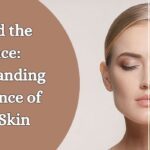In a world where youth is often equated with vigor, understanding the narrative written on our skin can be empowering. The health and beauty industry is replete with products and treatments promising to roll back the years, but it’s important to cultivate not just a skincare routine, but a comprehension of why our skin ages. By demystifying the complex biological processes involved in skin aging, consumers can move beyond superficial quick fixes and toward a deeper, scientifically grounded approach to long-term skin health.

The Basics of Aging Skin
Skin aging is a natural process influenced by a combination of genetic factors and environmental exposures. Understanding its fundamental mechanisms is essential for adopting effective skin care practices.
Intrinsic and Extrinsic Factors
Our skin evolves with time, influenced by both intrinsic and extrinsic factors. Intrinsic aging, also known as the natural aging process, is largely determined by genetics and proceeds at a fixed rate. Extrinsic aging, on the other hand, is driven by environmental elements, such as sun exposure, diet, and pollution, and leads to premature aging. Understanding these dual forces is the first step in crafting a holistic approach to skin health.
Common Signs of Aging Skin
The mirror can serve as an intuitive, if sometimes dreaded, signal of the passing years. Common signs of aging skin include fine lines, wrinkles, loss of elasticity, and a decrease in the skin’s moisture content. These characteristics, though superficial, provide valuable visual cues to the underlying physiological changes occurring within our skin cells.
Scientific Insights into Skin Aging
The exploration of the science of skin aging offers a fascinating glimpse into how our bodies change over time. Delving into the cellular and molecular mechanisms allows for an appreciation of the complexity behind what we often see as merely aesthetic changes.
Cellular Changes and Their Impacts
At the cellular level, aging skin undergoes a series of transformations. The turnover of skin cells slows down, leading to a buildup of dead cells on the skin’s surface. There’s a decrease in the production of natural skin oils, which help maintain the skin’s barrier function, and cellular repair mechanisms become less efficient, contributing to a weakened and thinned skin structure.
The Collagen and Elastin Connection
Collagen and elastin are the twin pillars of youthful skin. Collagen provides the skin with its structure, and elastin gives it the ability to stretch and bounce back. With age, the production of these vital proteins declines, resulting in sagging and the formation of wrinkles. External stressors further accelerate this breakdown, underscoring the importance of preventative and reparative skincare measures.
Antioxidants and the Battle Against UV Damage
The science of aging skin also highlights the role of antioxidants in our skincare arsenal. These molecules quench free radicals, which are highly reactive species that can damage cells, including those in the skin. Sun exposure, in particular, can lead to an onslaught of free radicals, underscoring the need for daily protection and the consumption of antioxidant-rich foods and supplements.
Effective Skincare Strategies
Adopting effective skincare strategies is crucial in the combat against the visible signs of aging. By integrating scientific insights into our daily routines, individuals can make informed decisions that nurture long-term skin health, instead of resorting to quick, ineffective solutions.
Hydration as a Fundamental
Maintaining proper hydration is a foundational component of any anti-aging regimen. Hydrated skin is resilient, plump, and reflects light evenly, providing the appearance of a more youthful complexion. This is achieved through both internal hydration, from drinking water, and external moisturization, via topical products.
The Power of Retinoids and Antioxidants
Retinoids, a class of compounds related to vitamin A, are among the most extensively studied and effective anti-aging ingredients. They work by increasing cell turnover and stimulating collagen production. Antioxidants, too, play a pivotal role, fortifying the skin against environmental stressors and promoting a radiant and even skin tone.
Sun Protection and Sensible Lifestyle Habits
A key component of responsible aging is the diligent use of broad-spectrum sunscreen. Sun damage is one of the most significant contributors to premature aging, emphasizing the importance of sun-safe behaviors. In addition, lifestyle choices such as diet, exercise, and avoiding tobacco and alcohol can either bolster or undermine our skin’s natural defenses.
In a world where youth is often equated with vigor, understanding the narrative written on our skin can be empowering. The health and beauty industry is replete with products and treatments promising to roll back the years, but it’s important to cultivate not just a skincare routine, but a comprehension of why our skin ages. By demystifying the complex biological processes involved in skin aging, consumers can move beyond superficial quick fixes and toward a deeper, scientifically grounded approach to long-term skin health.
The Basics of Aging Skin
Skin aging is a natural process influenced by a combination of genetic factors and environmental exposures. Understanding its fundamental mechanisms is essential for adopting effective skin care practices.
Intrinsic and Extrinsic Factors
Our skin evolves with time, influenced by both intrinsic and extrinsic factors. Intrinsic aging, also known as the natural aging process, is largely determined by genetics and proceeds at a fixed rate. Extrinsic aging, on the other hand, is driven by environmental elements, such as sun exposure, diet, and pollution, and leads to premature aging. Understanding these dual forces is the first step in crafting a holistic approach to skin health.
Common Signs of Aging Skin
The mirror can serve as an intuitive, if sometimes dreaded, signal of the passing years. Common signs of aging skin include fine lines, wrinkles, loss of elasticity, and a decrease in the skin’s moisture content. These characteristics, though superficial, provide valuable visual cues to the underlying physiological changes occurring within our skin cells.
Scientific Insights into Skin Aging
The exploration of the science of skin aging offers a fascinating glimpse into how our bodies change over time. Delving into the cellular and molecular mechanisms allows for an appreciation of the complexity behind what we often see as merely aesthetic changes.
Cellular Changes and Their Impacts
At the cellular level, aging skin undergoes a series of transformations. The turnover of skin cells slows down, leading to a buildup of dead cells on the skin’s surface. There’s a decrease in the production of natural skin oils, which help maintain the skin’s barrier function, and cellular repair mechanisms become less efficient, contributing to a weakened and thinned skin structure.
The Collagen and Elastin Connection
Collagen and elastin are the twin pillars of youthful skin. Collagen provides the skin with its structure, and elastin gives it the ability to stretch and bounce back. With age, the production of these vital proteins declines, resulting in sagging and the formation of wrinkles. External stressors further accelerate this breakdown, underscoring the importance of preventative and reparative skincare measures.
Antioxidants and the Battle Against UV Damage
The science of aging skin also highlights the role of antioxidants in our skincare arsenal. These molecules quench free radicals, which are highly reactive species that can damage cells, including those in the skin. Sun exposure, in particular, can lead to an onslaught of free radicals, underscoring the need for daily protection and the consumption of antioxidant-rich foods and supplements.
Effective Skincare Strategies
Adopting effective skincare strategies is crucial in the combat against the visible signs of aging. By integrating scientific insights into our daily routines, individuals can make informed decisions that nurture long-term skin health, instead of resorting to quick, ineffective solutions.
Hydration as a Fundamental
Maintaining proper hydration is a foundational component of any anti-aging regimen. Hydrated skin is resilient, plump, and reflects light evenly, providing the appearance of a more youthful complexion. This is achieved through both internal hydration, from drinking water, and external moisturization, via topical products.
The Power of Retinoids and Antioxidants
Retinoids, a class of compounds related to vitamin A, are among the most extensively studied and effective anti-aging ingredients. They work by increasing cell turnover and stimulating collagen production. Antioxidants, too, play a pivotal role, fortifying the skin against environmental stressors and promoting a radiant and even skin tone.
Sun Protection and Sensible Lifestyle Habits
A key component of responsible aging is the diligent use of broad-spectrum sunscreen. Sun damage is one of the most significant contributors to premature aging, emphasizing the importance of sun-safe behaviors. In addition, lifestyle choices such as diet, exercise, and avoiding tobacco and alcohol can either bolster or undermine our skin’s natural defenses.
Innovations in Anti-Aging Treatments
The quest for youthful skin has fueled remarkable advancements in dermatological science. Consult a dermatologist in Salt Lake City or elsewhere to explore the latest, evidence-based treatment options.
Advanced Skincare Technologies
Advancements in dermatological technologies have opened up new frontiers in anti-aging treatments. From laser therapies that target fine lines and discoloration to microneedling devices that stimulate the skin’s natural regeneration process, these innovations offer sophisticated solutions for those seeking more pronounced results.
Emerging Dermatology and Cosmetology Trends
The pursuit of youthful skin has also given rise to emerging trends in both medical and cosmetic procedures. Non-invasive techniques like radiofrequency treatments and injectables that mimic the actions of collagen and hyaluronic acid are gaining popularity, offering patients an expanded spectrum of customizable anti-aging interventions.
Conclusion
Now, more than ever, we have access to a wealth of information and resources that empower us to navigate the complex world of skin aging with confidence. By understanding the intrinsic and extrinsic factors at play, adopting effective skincare strategies, and taking advantage of innovative treatments, we can take proactive steps toward maintaining youthful skin well into our golden years. So go ahead and shine bright like the radiant, ageless beauty that you are! And remember to always prioritize your skin health, because, after all, it’s the first thing people see when they look at you.






Leave a Reply